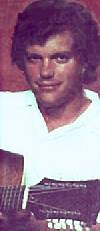Leo Kottke
by Mark Humphrey
 |
"This cheap cassette by Leo Kottke, with a lot of distortion, came in to us," John Fahey recalls, "and I listened to it and I said, 'Wow, that's great! It's beautiful music, and I bet it would sell.' Everyone else in the Takoma Records office said, 'Oh, no, he just plays like you. It'll never sell.' But I was running things, and so we put it out." To date, 6 & 12 String Guitar has sold over 400,000 copies, a remarkable feat for a solo guitar album. But Kottke (then in his early twenties, though he claimed in his liner notes to be 102) was a remarkable guitarist -- something akin to John Fahey in overdrive, a propulsive right hand pumping like a steam engine and a weeping bottleneck style that sounded tipsy and walked the straightest of lines at the same time.
A graduate cum laude of Fahey's school of "American primitive guitarists" (primitive, according to the old Maestro, in the sense of Grandma Moses and other untutored painters) , Kottke went on to wow the world, working such unlikely venues as rock festivals and The Merv Griffin Show. Despite heavy media attention, he managed to balance his digital pyrotechnics with the "aw, shucks" manners of a midwestern farm boy who just happened to have this knack for making an acoustic guitar roar like a Mack truck.
Several thousand concerts and a few record labels since the cheap cassette caught Fahey unawares, Kottke is still the same unassuming, boyish character, comfortable as an old shoe. His music has gone through a few tortured twists and turns since then, but has returned to something akin to 6 & 12 String Guitar in his latest effort, Guitar Music. He maintains a wry sense ofhumor as well an ability to articulate his own strengths, weaknesses, and the peculiar talents that make him what one critic called a "pop virtuoso." He speaks with typical candor in the following interview.
When you first became interested in taking up the guitar, how old were you?
I was eleven. I've been playing for 24 years now. My right-hand pattern started out with a guy in Muskogee, Oklahoma, who I only saw once. I was staying with some people, and this guy came down the hall playing a fingerpicking pattern. Up until then, I had only heard a record, Flamenco Fire [ABC, 157, out of print], with Sabicas and Carlos Montoya and some classical stuff, but I had never heard anything like that, and I really went right through the roof. He showed me how to do it, and it's the foundation for everything I've done since.
You once said that the advances you have made in your right-hand technique come from trying to play banjo. How did that affect you?
By trying to learn the Earl Scruggs technique, it got me out of a rut that I had dug for myself with the pattern I had learned in Muskogee. It broke it open, and now when I play I'm always in the middle of something, but I never start or finish it in terms of what is mechanically happening in my right hand. When I moved to Virginia, I wanted to play banjo and found out about Pete Seeger and went off through his stuff, because of the "Goofing Off Suite" [Goofing Off Suite, Folkways (43 W. 61st St., New York, NY 100231), 2045] and the occasional instrumental he would stick in. He did an album with Frank Hamilton called Nonesuch [Folkways, 2439] that was all instrumental. Some of it was kind of peculiar, and some of it was really good.
Did the 1960s coffeehouse scene have on influence on you?
Yes. I that for 3 1/2 years before I made that record for Fahey, and it was really good for me. You get a chance to make a fool of yourself without getting too hurt by the consequences.
Robbie Basho recalls you hanging out with him in Washington. D.C.
He had a big effect on me. He had an old 12-string guitar and used to wear cowboy outfits and carry around Japanese movie review books. He sang a lot more a traditional mode back then, and I always loved his voice -- it was really good, and spooky . I'd keep trying to talk to him, and one night at a place called the Unicorn I was following him and I said, "Gee, I'm really kind of nervous, because I've been listening to you so much, I'm afraid I'm going to sound a lot like you." And he said "Aw, that's all right, we all go through somebody sooner or later."
Did you know Fahey at that time?
No, that was a lot later, though I think one night I may have heard him without knowing it at the University of Maryland.
How has Fahey influenced your slide playing?
The reason Fahey got me interested in slide was because I heard his version of Bukka White's "Poor Boy" [Blind Joe Death, Takoma (9255 Sunset Blvd., Los Angeles 90069), TAK 7015] and it didn't sound like Delta stuff; it had some major chords. A lot of the blues I know about I have only absorbed by listening to Fahey. It has only been in the last few years that I've found out about them. I used to listen to a lot of hillbilly music and folk music, and I just couldn't respond to Delta stuff. I saw [blues guitarists] Skip James and John Hurt around '64 in D.C. I enjoyed John Hurt a lot. Later on I was squashed by [blues guitarist] Fred McDowell one night at a party where I heard him play for three hours. He was off in a room by himself, closed his eyes and didn't open them again. I figured a couple of things out that night.